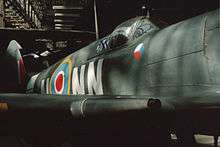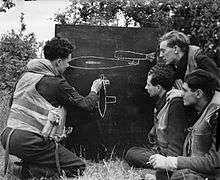No. 310 Squadron RAF
No. 310 Squadron RAF was a Czechoslovak-manned fighter squadron of the Royal Air Force in the Second World War.
| No. 310 Squadron RAF | |
|---|---|
 Badge of № 310 Squadron RAF | |
| Active | 29 July 1940 – 15 February 1946 |
| Country | |
| Allegiance | |
| Branch | |
| Role | Day Fighting |
| Motto(s) | We Fight to Rebuild |
| Engagements | Battle of Britain Normandy landings |
| Insignia | |
| Squadron Badge | In front of a sword erect, a lion rampant queue fourches |
| Squadron Codes | NN (July 1940 – February 1946) |
History
The squadron was formed on 10 July 1940 at RAF Duxford.[1] It was the first RAF squadron to be raised crewed by foreign nationals, in this case escaped Czechoslovak pilots. Initially it had two Squadron Leaders: the British Douglas Blackwood[2] and the Czechoslovak Alexander Hess.[3][4] Hess and many of his men had served in the Czechoslovak Air Force, escaped from Czechoslovakia after it was occupied by Nazi Germany, and then joined the French Air Force and fought in the Battle of France.
Initially the squadron was equipped with Hawker Hurricane I fighters.[1] The squadron was operational in only a month and as part of 12 Group[2] took part in the Battle of Britain as part of the Duxford Big Wing. The squadron claimed 37½ victories in the battle.
_Squadron_RAF_in_front_of_Hawker_Hurricane_Mk_I_at_Duxford%2C_Cambridgeshire%2C_7_September_1940._CH1299.jpg)
From 1941 the squadron began offensive operations flying sweeps over the English Channel and providing bomber escorts. In 1941 Hess was transferred to be a Czechoslovak liaison officer at Fighter Command, and on 28 February Sqn Ldr František Weber succeeded him in command of 311 Squadron.[4]
In March 1941 the squadron was re-equipped with the Hurricane II. On 26 June it moved to RAF Martlesham Heath[5] in Suffolk. On 19 July 1941 the squadron moved again, to RAF Dyce[5] in Scotland, to rest. It was re-equipped with the Supermarine Spitfire IIa and Vb in October 1941.[6]
On 14 December 1941 the squadron moved to RAF Perranporth[7] in Cornwall for defensive operations. On 7 April 1942 Sqn Ldr František Doležal succeeded Weber as squadron commander. On 7 May the squadron moved to RAF Exeter.[7]
On 15 January 1943 Doležal was succeeded by Sqn Ldr Emil Foit.[4] On 26 June 1943 the squadron moved to RAF Castletown[7] in Caithness, Scotland for another three-month rest period. From July to September it operated the Spitfire VI.[6] On 18 September 1943 the squadron moved to RAF Ibsley[7] in Hampshire.
On 13 January 1944 Sqn Ldr Hugo Hrbáček succeeded Foit as squadron commander.[5] On 20 February the squadron moved to RAF Mendlesham in Suffolk, on 29 March it moved again to RAF Rochford in Essex, and on 3 April it moved again to RAF Appledram in Hampshire.[7] On 21 May Sqn Ldr Václav Raba succeeded Hrbáček as squadron commander.[5]

In 1944 the squadron was re-equipped with the Spitfire IX and became a fighter-bomber unit with 134 Wing, flying ground attack duties during the Normandy landings. From 22 June until 4 July the squadron was based at RAF Tangmere in West Sussex, and from 4 to 11 July it was based at RAF Lympne in Kent.[7]
On 11 July 1944 the squadron moved to RAF Digby in Lincolnshire, and on 28 August it moved again to RAF North Weald in Essex.[8] On 15 September Sqn Ldr Jiří Hartman succeeded Raba as squadron commander.[5] The squadron then spent the rest of the war flying armed reconnaissance missions along the Dutch and Belgian coasts. On 29 December 1944 it moved to RAF Bradwell Bay in Essex, and on 27 February 1945 the squadron moved to RAF Manston in Kent.[8]

The squadron's final score was 52½ claims including four V-1 flying bombs shot down. Three of those flying bombs were shot down on 8 July by the same fighter ace, Flt Lt Otto Smik DFC, in one sortie, within 32 minutes of each other.[9]
On 7 August 1945 the squadron moved to Hildesheim, and on 31 August it moved again to Ruzyně Airport in Prague.[8] It became a squadron of the new Czechoslovak Air Force,[6] and on 15 February 1946 was officially disbanded as an RAF squadron.[1]
Aircraft operated
| From | To | Aircraft | Variant | Notes |
|---|---|---|---|---|
| July 1940 | March 1941 | Hawker Hurricane | I | |
| March 1941 | December 1941 | Hawker Hurricane | IIa | |
| June 1941 | November 1941 | Hawker Hurricane | IIb | |
| October 1941 | December 1941 | Supermarine Spitfire | IIa | |
| November 1941 | March 1944 | Supermarine Spitfire | Vb | |
| July 1942 | June 1943 | Supermarine Spitfire | Vc | |
| July 1943 | September 1943 | Supermarine Spitfire | VI | |
| September 1943 | March 1944 | Supermarine Spitfire | Vc | |
| January 1944 | July 1944 | Supermarine Spitfire | LF.IX | |
| July 1944 | September 1944 | Supermarine Spitfire | Vb | |
| August 1944 | February 1946 | Supermarine Spitfire | LF.IX | |
References
Notes
- Lewis 1968, p. 96.
- "Fighter Command". British, Colonial, and Dominion Air Forces — Battle of Britain —. Retrieved 1 February 2018.
- "Squadron Commanding Officers, Nos 300 - 361 Squadrons". Air of Authority – A History of RAF Organisation.
- van Eyck 1993, p. 13.
- van Eyck 1993, p. 14.
- Jackson 2003, p. 89.
- van Eyck 1993, p. 15.
- van Eyck 1993, p. 16.
- "Otto Smik". Free Czechoslovak Air Force. 19 August 2010. Retrieved 7 November 2017.
- Halley 1988, p. 362.
- Rawlings 1978, p. 397.
Bibliography
- Halley, James J (1988). The Squadrons of the Royal Air Force & Commonwealth, 1918–1988. Tonbridge: Air-Britain (Historians) Ltd. ISBN 0-85130-164-9.CS1 maint: ref=harv (link)
- Hurt, Zdeněk (2004). In Focus: Czechs in the RAF. Walton-on-Thames: Red Kite. ISBN 0-9538061-9-7.CS1 maint: ref=harv (link)
- Jackson, Robert (2003). Spitfire The History of Britain's Most Famous World War II Fighter. Bath: Parragon. p. 89. ISBN 0-75258-770-6.CS1 maint: ref=harv (link)
- Jefford, Wg Cdr CG (2001) [1998]. RAF Squadrons, A Comprehensive Record of the Movement and Equipment of all RAF Squadrons and their Antecedents since 1912 (second ed.). Shrewsbury: Airlife Publishing. ISBN 978-1-84037-141-3.CS1 maint: ref=harv (link)
- Lewis, Peter (1968) [1959]. Squadron Histories, RFC, RNAS and RAF, Since 1912. London: Putnam. p. 96. SBN 370-00022-6.CS1 maint: ref=harv (link)
- Polak, Tomas; Rajlich, Jiří; Vancata, Pavel (2008). No. 310 (Czechoslovak) Squadron, 1940–45: Hurricane, Spitfire. France: www.RAF-in-Combat.com. ISBN 2-9526381-1-X.CS1 maint: ref=harv (link)
- Rawlings, John DR (1976) [1969]. Fighter Squadrons of the RAF and their Aircraft (new ed.). London: Macdonald and Jane's (Publishers) Ltd. ISBN 0-354-01028-X.CS1 maint: ref=harv (link)
- van Eyck, Manuel F (1993). Zemřeli jsme pro Anglii (in Czech). Translated by František Fajtl. prologue by František Fajtl. Prague: Naše vojsko. ISBN 80-206-0321-2.CS1 maint: ref=harv (link)
External links
| Wikimedia Commons has media related to No. 310 (Czechoslovak) Squadron RAF. |
- "310 Squadron". History RAF Formations. Ministry of Defence. Archived from the original on 11 July 2017. Retrieved 11 October 2017.
- "No. 310 (Czechoslovak) Squadron RAF". RAF Fighter Command 1939 – 1945. Royal Air Force Commands. 2013. – movement and equipment history
- "No 310 (Czechoslovak) Squadron". Air of Authority – A History of RAF Organisation.
- Darlington, Roger. "Czechoslovaks in the RAF".
- Vančata, Pavel (1999). "No. 310 Czechoslovak Fighter Squadron". Archived from the original on 21 July 2015. – lists of locations, squadron commanders, flight commanders and aircraft types
- Vančata, Pavel (2002). "List of Czechoslovak airmen at No. 310 Czechoslovak Fighter Squadron". Archived from the original on 16 July 2015. – list of all members
